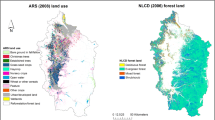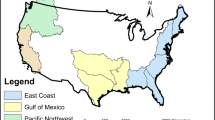Abstract
Dissolved total nitrogen (Nt) and total organic carbon (TOC) exports were measured from 30 catchments and regions draining 76 % of the Canadian landscape in order to estimate reactive N and organic C runoff losses to estuaries and the conditions that control them. N exports from the catchments were lower than measured in most of Europe and the United States due to significantly less agricultural activity and atmospheric deposition, especially in northern Canada. We produce statistical models using a number of geographical, climatic, agricultural, and population factors in order to predict N and C losses from the remaining regions. Using measured and extrapolated data, we estimated that the Canadian landscape exports 884 and 18,210 ktons of Nt and OC per year. Area normalized exports ranged from 29.4 kg km−2 for the northern Mackenzie River to 299 kg km−2 for the semi-agricultural Saint John. Area normalized OC exports ranged from 495 kg km−2 in the high Arctic to 7,295 to the wetland dominated Broadback River in northern Quebec. N exports were best predicted by the latitude of the catchment centroid, mean slope, population density, runoff and % of the catchment as agricultural land. The best model for predicting TOC exports needed only slope and runoff. The Nt/OC ratio in the rivers unsurprisingly was highest in the southern portion of the country where anthropogenic activities were concentrated.





Similar content being viewed by others
References
Alvarez-Cobelas M, Angeler DG, Sanchez-Carrillo S, Almendros G (2012) A worldwide view of organic carbon export from catchments. Biogeochemistry 107:275–293
Barnett PJ, Yeung KH, McCallum JD (2011) Surficial geology of the Harricana River area northwest, northern Ontario. Ontario Geological Survey: preliminary map P.3751, scale 3751:3100 3000
Behrendt H, Opitz D (2000) Retention of nutrients in river systems: dependence on specific runoff and hydraulic load. Hydrobiology 410:111–122
Billen G, Silvestre M, Grizzetti B, Leip A, Garnier J, Voss M, Howarth R, Bouraoui F, Lepistö A, Kortelainen P, Johnes P, Curtis C, Humborg C, Smedberg E, Kaste Ø, Ganeshram R, Beusen A, Lancelot C (2011) Nitrogen flows from European regional watersheds to coastal marine waters. In: Sutton MA, Howard CM, Erisman JW, Billen G, Bleeker A, Grennfelt P, van Grinsven H, Grizzetti B (eds) The European nitrogen assessment. Cambridge University Press, Cambridge, pp 272–297
Boyer EW, Howarth RW (2008) Nitrogen fluxes from rivers to the coastal ocean. In: Capone DG, Bronk DA, Mulholland MR, Carpenter EJ (eds) Nitrogen in the marine environment, 2nd edn. Academic Press, New York, pp 1565–1587
Boyer EW, Howarth RW, Galloway JN, Dentener FJ, Green PA, Vörösmarty CJ (2006a) Riverine nitrogen export from the continents to the coasts. Glob Biogeochem Cycl 20:GB1S91. doi:10.1029/2005GB002537
Boyer EW, Alexander RB, Parton WJ, Li C, Butterbach-Bahl K, Donner SD, Skaggs RW, Del Grosso SJ (2006b) Modeling denitrification in terrestrial and aquatic ecosystems at regional scales. Ecol Appl 16(6):2123–2142
Clair TA, Pollock TL, Ehrman JM (1994) Exports of carbon and nitrogen from river basins in Canada’s Atlantic provinces. Glob Biogeochem Cycl 8:441–450
Clair TA, Ehrman JM, Higuchi K (1999) Changes in freshwater carbon exports from Canadian terrestrial basins to lakes and estuaries under a 2xCO2 atmospheric scenario. Glob Biogeochem Cycl 13:1091–1097
Cole J, Prairie Y, Caraco N, McDowell W, Tranvik L, Striegl R, Duarte C, Kortelainen P, Downing J, Middelburg J, Melack J (2007) Plumbing the global carbon cycle: integrating inland waters into the terrestrial carbon budget. Ecosystems 10(1):172–185
Cronan C (2012) Biogeochemistry of the Penobscot River watershed, Maine, USA: nutrient export patterns for carbon, nitrogen, and phosphorus. Environ Monit Assess 184(7):4279–4288
Diaz RJ, Rosenberg R (2008) Spreading dead zones and consequences for marine ecosystems. Science 321:926–929
Emmerton CA, Lesack LFW, Marsh P (2007) Lake abundance, potential water storage, and habitat distribution in the Mackenzie River delta, western Canadian Arctic. Water Resour Res 43:W05419
Galloway JN, Townsend AR, Erisman JW, Bekunda M, Cai Z, Freney JR, Martinelli LA, Seitzinger SP, Sutton MA (2008) Transformation of the nitrogen cycle: recent trends, questions, and potential solutions. Science 320:889–892
Gergel SE, Turner MG, Kratz TK (1999) Dissolved organic carbon as an indicator of the scale of watershed influence on lakes and rivers. Ecol Appl 9:1377–1390
Goolsby DA, Battaglin WA (2001) Long-term changes in concentrations and flux of nitrogen in the Mississippi River Basin, USA. Hydrol Process 15:1209–1226
Green PA, Vörösmarty CJ, Meybeck M, Galloway JN, Peterson BJ, Boyer EW (2004) Pre-industrial and contemporary fluxes of nitrogen through rivers: a global assessment based on typology. Biogeochemistry 68:71–105
Gruber N, Galloway JN (2008) An Earth-system perspective of the global nitrogen cycle. Nature 451:293–296
Holeton C, Chambers PA, Grace L (2011) Wastewater release and its impacts on Canadian waters. Can J Fish Aquat Sci 68:1836–1859
Holmes R, McClelland J, Peterson B, Tank S, Bulygina E, Eglinton T, Gordeev V, Gurtovaya T, Raymond P, Repeta D, Staples R, Striegl R, Zhulidov A, Zimov S (2012) Seasonal and annual fluxes of nutrients and organic matter from large rivers to the Arctic Ocean and surrounding seas. Estuaries Coasts 35:369–382
Howarth R, Billen G, Swaney D, Townsend A, Jaworski N, Lajtha K, Downing J, Elmgren R, Caraco N, Jordan T, Berendse F, Freney J, Kudeyarov V, Murdoch P, Zhao-Liang Z (1996) Regional nitrogen budgets and riverine N & P fluxes for the drainages to the north Atlantic Ocean: natural and human influences. Biogeochemistry 35:75–139
Howarth RW, Swaney DP, Boyer EW, Marino R, Jaworski N, Goodale C (2006) The influence of climate on average nitrogen export from large watersheds in the Northeastern United States. Biogeochemistry 79:163–186
Howarth R, Swaney D, Billen G, Garnier J, Hong B, Humborg C, Johnes P, Mörth C-M, Marino R (2012) Nitrogen fluxes from the landscape are controlled by net anthropogenic nitrogen inputs and by climate. Front Ecol Environ 10:37–43
Khalili MI, Temnerud J, Fröberg M, Karltun E, Weyhenmeyer GA (2010) Nitrogen and carbon interactions between boreal soils and lakes. Glob Biogeochem Cycl 24(4):GB4011
Koprivnjak JF, Blanchette JG, Bourbonniere RA, Clair TA, Heyes A, Lum KR, McRae R, Moore TR (1995) The underestimation of concentrations of dissolved organic carbon in freshwaters. Water Res 29:91–94
Kroeze C, Bouwman L, Seitzinger S (2012) Modeling global nutrient export from watersheds. Curr Opin Environ Sustainability 4(2):195–202
Lauerwald R, Hartmann J, Ludwig W, Moosdorf N (2012) Assessing the nonconservative fluvial fluxes of dissolved organic carbon in North America. J Geophys Res 117(G1):G01027
Lewis WM, Melack JM, McDowell WH, McClain M, Richey JE (1999) Nitrogen yields from undisturbed watersheds in the Americas. Biogeochemistry 46:149–162
Moran MD, Zheng Q, Pavlovic R, Cousineau S, Bouchet VS, Sassi M, Makar PA, Gong W, Stroud C (2008) Predicted acid deposition critical-load exceedances across Canada from a one-year simulation with a regional particulate-matter model. Proceedings of the 15th Joint AMS/A&WMA conference on applications of air pollution meteorology, American Meteorological Society, New Orleans, Jan. 21–24
Pocklington R, Tan FC (1987) Seasonal and annual variations in the organic matter contributed by the St Lawrence River to the Gulf of St Lawrence. Geochimica Cosmochimica Acta 51(9):2579–2586
Raymond PA, McClelland JW, Holmes RM, Zhulidov AV, Mull K, Peterson BJ, Striegl RG, Aiken GR, Gurtovaya TY (2007) Flux and age of dissolved organic carbon exported to the Arctic Ocean: a carbon isotopic study of the five largest arctic rivers. Glob Biogeochem Cycl 21(4):GB4011
Rosa E, Hillaire-Marcel C, Ghaleb B, Dick TA (2012) Environmental and seasonal controls on riverine dissolved uranium in the Hudson, James, and Ungava bays region, Canada. Can J Earth Sci 49:758–771
Schaefer S, Hollibaugh JT, Alber M (2009) Watershed nitrogen input and riverine export on the west coast of the US. Biogeochemistry 93:219–233
Schlesinger WH, Reckhow KH, Bernhardt ES (2006) Global change: the nitrogen cycle and rivers. Water Resour Res 42:385–409. doi:10.1029/2005WR004300
Schlünz B, Schneider RR (2000) Transport of terrestrial organic carbon to the oceans by rivers: re-estimating flux- and burial rates. Int J Earth Sci 88:599–606
Scott D, Harvey J, Alexander R, Schwarz G (2007) Dominance of organic nitrogen from headwater streams to large rivers across the conterminous United States. Glob Biogeochem Cycl 21:GB1003
Scott KJ, McCullough G, Stainton M, Ayles B, Hann B (2011) Lake Winnipeg—state of the science: what is the scientific basis for understanding and protecting lake Winnipeg? Lake Winnipeg Research Consortium Inc., Science Workshop. Winnipeg, Canada, p 178
Seitzinger S, Harrison JA, Böhlke JK, Bouwman AF, Lowrance R, Peterson B, Tobias C, Drecht GV (2006) Denitrification across landscapes and waterscapes: a synthesis. Ecol Appl 16:2064–2090
Spence C, Burke A (2008) Estimates of Canadian Arctic Archipelago runoff from observed hydrometric data. J Hydrol 362:247–259
Striegl RG, Dornblaser MM, Aiken GR, Wickland KP, Raymond PA (2007) Carbon export and cycling by the Yukon, Tanana, and Porcupine rivers, Alaska, 2001–2005. Water Resour Res 43:WO2411. doi:10.1029/2006WR005201
Sutton MA, Howard CM, Erisman JW, Billen G, Bleeker A, Grennfelt P, van Grinsven H, Grizzetti B (2011) The European nitrogen assessment. Cambridge University Press, Cambridge
Swaney DP, Hong B, Ti C, Howarth RW, Humborg C (2012) Net anthropogenic nitrogen inputs to watersheds and riverine N export to coastal waters: a brief overview. Curr Opin Environ Sustainability 4:203–211
Thomas H, Shadwick E, Dehairs F, Lansard B, Mucci A, Navez J, Gratton Y, Prowe F, Chierici M, Fransson A, Papakyriakou TN, Sternberg E, Miller LA, Tremblay J-É, Monnin C (2011) Barium and carbon fluxes in the Canadian Arctic Archipelago. J Geophys Res 116:C00G08
Vet R, Brook J, Ro C-U, Shaw M, Narayan J, Zhang L, Moran MA, Lusis M (2005) Atmospheric Response to Past Emission Control Programs, Chapter 3, Canadian 2004 acid deposition science assessment. Government of Canada, Canada pp 15-98
Vörösmarty CJ, Fekete BM, Meybeck M, Lammers RB (2000) Global system of rivers: its role in organizing continental land mass and defining land-to-ocean linkages. Glob Biogeochem Cycl 14:599–621
Wollheim WM, Vörösmarty CJ, Bouwman AF, Green P, Harrison J, Linder E, Peterson BJ, Seitzinger SP, Syvitski JPM (2008) Global N removal by freshwater aquatic systems using a spatially distributed, within-basin approach. Glob Biogeochem Cycl 22(2):GB2026
Zbieranowski AL, Aherne J (2011) Long-term trends in atmospheric reactive nitrogen across Canada: 1988–2007. Atmos Environ 45:5853–5862
Acknowledgments
The authors thank Roger Shetagne of Hydro Québec, Allison Zacharias of the Manitoba/Manitoba Hydro Coordinated Aquatic Monitoring Program and Elaine Page of Manitoba Water Stewardship for providing data from rivers draining into Hudson Bay. Thomas Jaegler of the University of Québec assisted with St Lawrence basin database contributions. From Environment Canada, Joseph Culp provided data from the Arctic, Denis Parent from the Atlantic Region, Myriam Rondeau for the St Lawrence, and Nancy Glozier for the Prairie and northern rivers. Finally, we thank the Associate Editor and two reviewers whose patience and constructive comments allowed us to improve our original submission.
Author information
Authors and Affiliations
Corresponding author
Appendix
Appendix
GIS and other data sources used in the analysis
Agricultural areas were defined using the Simple Biosphere model of the North American Land Cover Characteristics Data Base, http://edcsns17.cr.usgs.gov/glcc/.
Catchment slope was calculated from USGS 30 arc-second DEM for North America corrected for hydrological features: http://eros.usgs.gov/#/Find_Data/Products_and_Data_Available/gtopo30/README.
The runoff data was mostly from the 1978 hydrological atlas of Canada http://atlas.nrcan.gc.ca/site/english/maps/archives/hydrological_atlas_1978/water_quantity_general/24_Annual_Runoff_1978.
River Drainage area was modified from the Canada National Atlas Major River Basin layer http://atlas.nrcan.gc.ca/site/english/maps/reference/national/drainbasins/referencemap_image_view and NRCan 2001, Atlas of Canada (rivers).
http://atlas.nrcan.gc.ca/site/english/learningresources/facts/rivers.html/#bay (Accessed Oct 27, 2011).
http://atlas.nrcan.gc.ca/site/english/maps/archives/5thedition/environment/water/mcr4055.
Population distribution was quantified from the Canadian Atlas (NRCan 2001): http://atlas.nrcan.gc.ca/site/english/maps/peopleandsociety/population/population2001/density2001 (accessed Oct. 19, 2011).
Water chemistry data from British Columbia and the Yukon were accessed at: http://waterquality.ec.gc.ca/waterqualityweb/searchtext.aspx?lang=EN.
Catchment biological characteristics were extracted from the Atlas of Canada (biomes) (NRCan 2001) http://atlas.nrcan.gc.ca/site/english/learningresources/theme_modules/borealforest/forest_regions.jpg/image_view (accessed Oct. 19, 2011).
Rights and permissions
About this article
Cite this article
Clair, T.A., Dennis, I.F. & Bélanger, S. Riverine nitrogen and carbon exports from the Canadian landmass to estuaries. Biogeochemistry 115, 195–211 (2013). https://doi.org/10.1007/s10533-013-9828-2
Received:
Accepted:
Published:
Issue Date:
DOI: https://doi.org/10.1007/s10533-013-9828-2




